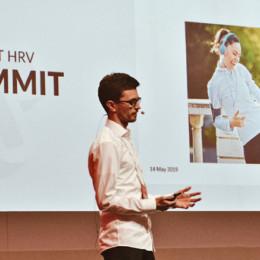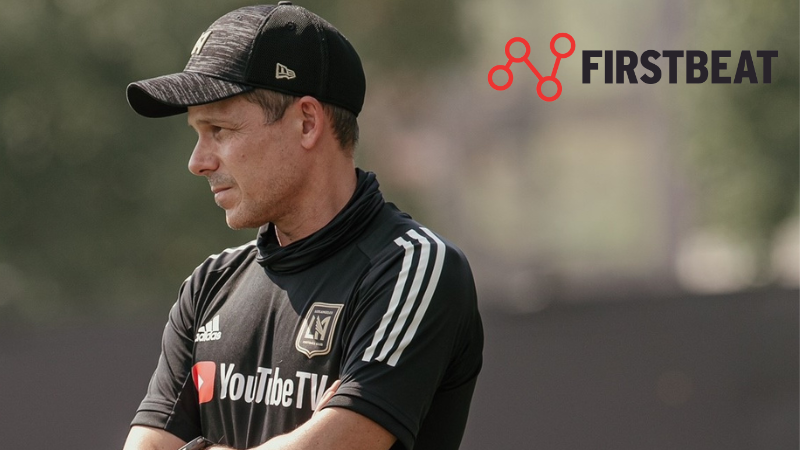
Los Angeles Football Club (LAFC), is a professional soccer team competing in Major League Soccer. In 2022, LAFC won the MLS Cup for the first time and the Supporters’ Shield, an annual award given to the Major League Soccer team with the best regular season record.
Firstbeat recently interviewed Gavin Benjafield, LAFC’s Performance Director, and asked him about the importance of internal load monitoring, his unconventional coaching team setup, and how he uses data to guide coaching decisions.
Watch the full webinar below to hear more of Gavin’s valuable insights and download our Firstbeat training load guide for soccer coaches to learn more about some of the metrics Gavin discussed in his interview.
Gavin’s Coaching Journey – From South Africa to Los Angeles
Originally from South Africa, Gavin’s coaching journey had already taken him from Africa and Asia to Europe working with teams including Ajax Amsterdam and Watford F.C. before he joined LAFC in the US in 2018.
“It has certainly been a journey,” Gavin explains. “I joined LAFC as an expansion team, and I had never worked with this thing called an expansion team before. There’s literally no history. There’s no infrastructure, there’s nothing. It’s a concept, and that was a huge appeal for me because obviously, I was working in other teams that were well-established for 20, 50, or 100 years before, then LAFC, 2018’s inaugural season was make it what you want, and so I think that was a great attraction for me.”
An Unconventional High-Performance Team Setup
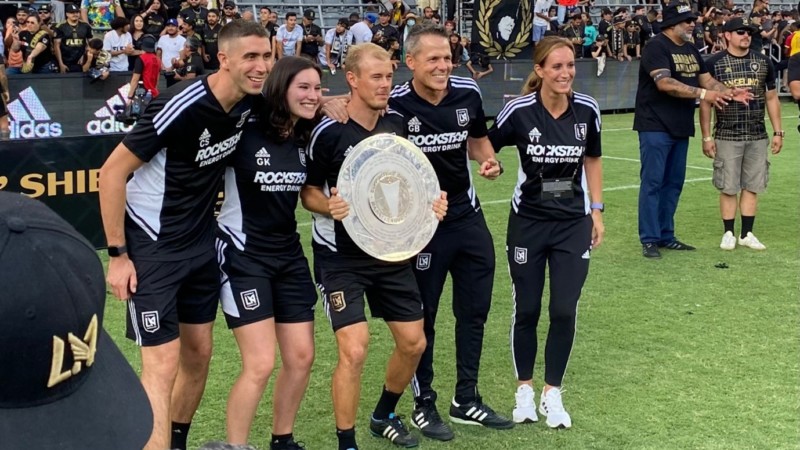
At first glance, Gavin’s team may look unconventional – with only two strength and conditioning coaches out of a staff of five, but he explains how focusing on specialization has actually made him more efficient as a strength and conditioning coach.
“At the beginning of last season, I wanted to go in a slightly different direction compared to the 15-plus years that I’ve done before where the performance or conditioning department was heavily weighted towards having a lot of strength and conditioning coaches on staff and we would always find ourselves carrying the load of nutrition, carrying the load of science.
Now, of course, some bigger teams would automatically have five strength and conditioning coaches, two full-time nutritionists, a whole bunch of data guys running around, and mental skills coaches as well. But with a smaller club and smaller budgets, we actually opted to go slightly differently.
So we have Connor, our full-time sports nutritionist. I mean, I’ve been in the industry for long enough, and I’m going to be able to put the basic foundations to work, but that’s not giving enough credit to this whole discipline of sports nutrition and how nutrition can aid performance, how nutrition can aid recovery, how nutrition can help with sleep. It’s just so much deeper than we can all appreciate.
And so I was like, if I have to sacrifice strength and conditioning position to have a full-time nutritionist on staff, I’ll do it. I didn’t have to make that sacrifice, but I did choose not to add more strength and conditioning coaches. I chose to add more specialization.
Then we have Georgia, who is our data wizard. If we want to look at data at a much deeper level and peel the layers of the onion in a way to get to the core of some of the questions that we’re trying to answer, then we need someone who is literally behind my desk. I’ll fire questions off to her and I’m expecting her to come back at the end of the day and say ‘Yeah, I’m working on it’. But within half an hour, she’s like, ‘Hey, do you want to come across and see what we’re doing?’
So this is a winning position for us. And with Connor as a full-time nutritionist for us, that takes a lot of responsibility off that just frees up my mind and it frees the mind of the strength and conditioning coach, Anton. Then we have Vicki, our mental performance coach. So if you really look at that performance department, that ratio doesn’t look right. But because Anton and I are free from having to deal with the small little headaches of supplementing this, or doing this, or creating this dataset. We’re able to maximize our time in the club as purists, pure strength conditioning coaches.”
The Importance of Internal Load Monitoring
Gavin has been using Firstbeat Sports to monitor internal load with LAFC since 2018 and explains why he thinks it’s important to monitor internal load in all sports.
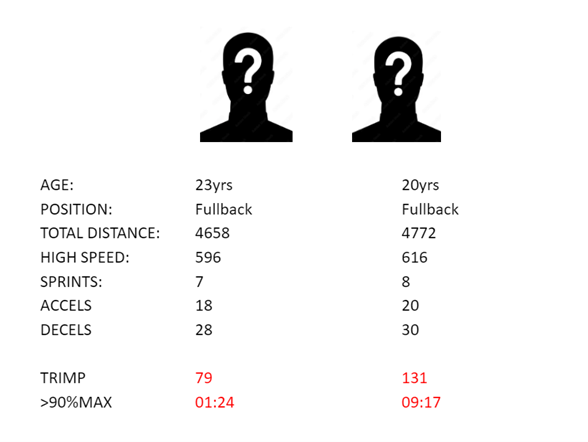
“The question always comes, why is it important to monitor internal load, in a sport, in soccer and rugby in whatever sport that you work in? I think the best example that I could come up with, what I always say is, at the end of the day, if you’re only looking at external, we could all have the athletes run 5 kilometers with a couple of high-speed efforts, with a couple of changes of directions.
And then we would say ‘Hey, they did exactly the same training session’. Yes, they did. They did exactly the same external training session, but we don’t know what that session actually cost them.
My brother-in-law and I drove down to Mexico for Thanksgiving. He has a non-hybrid and I have a kind of semi-hybrid car and he had to stop for gas and I still had half a tank of gas left. But we drove exactly the same distance.
So if we use that hybrid analogy, so player A, maybe one might be slightly older than the other, in exactly the same position. If you look at all the external metrics that maybe your team would be looking at, it looks like a pretty similar session.
Just shy of 5 kilometers, and an equal amount of high-speed runs, almost the same number of sprints, accels, decels. So it’s like you pretty much drove the same distance right?
You drove down to Mexico, and pretty much covered the same distance, but interestingly enough, it costs the younger athlete way more compared to the older athlete, although the perceived exertion of the older athlete, the 23-year-old, both of them get an RPE of 7 on the day.
Now RPE is a subjective rating of perceived exertion. That could be that the athlete didn’t sleep really well, maybe his kids were up at night a couple of times, and so he’s tired coming in training. Although internally when you measure what that actually cost him, it’s significantly less than the other.
And so that’s why measuring internal load, although putting another thing on the athlete, having them wear one more thing, having to download more data, having to collect more data is sometimes annoying. But without it, you’re actually driving with one eye closed.”
The Heavy Demands of Travel on US Players
Compared to traveling to matches in Europe, Gavin has found that the extensive travel demands for soccer players in the US can definitely take a toll on the team, meaning extra care is taken when it comes to athlete recovery, particularly for new players.
“In the Netherlands, we used to jump on the bus and get to the stadium within like an hour. And then if we had to go up north, we’d go the day before the trip so we would take two and a half hours and spend the night in the hotel.
But the majority of traveling in the US is extensive, our only local is when we play the Galaxy then it’s a bus trip down the road. But for everything else, you jump on a flight and that could be anything from two to six hours. It could be time zone changes. So if we go to the east coast then we’re going to obviously have three-hour time zone differences. It can be in the Texas region, where you wake up at 8 am in the morning thinking ‘I’m going to go for a walk and go find a good coffee spot. You walk outside and it’s already 32 degrees.
Or we’re about to go to Colorado and there it’s going to be the altitude. And so I’m not saying other leagues don’t experience this but maybe they won’t experience it on such a regular occurrence. This is week in, week out for us. So there’s a huge traveling demand and environmental stressors there as well. Our athletes are exposed to maybe certain things that other athletes around the globe are not and so we need to pay even more special attention to recovery strategies, the recovery of the athlete, the game demand in elevation, and the game demand in heat as well.
So yes, we do a lot of traveling and our athletes get used to that obviously, but for the European guys that just come into the market, it’s interesting to watch them for the first year when they’re like, ‘oh my goodness, another flight to another game, to another time zone.’”
How Live Monitoring Helps Guide In-Training Decisions
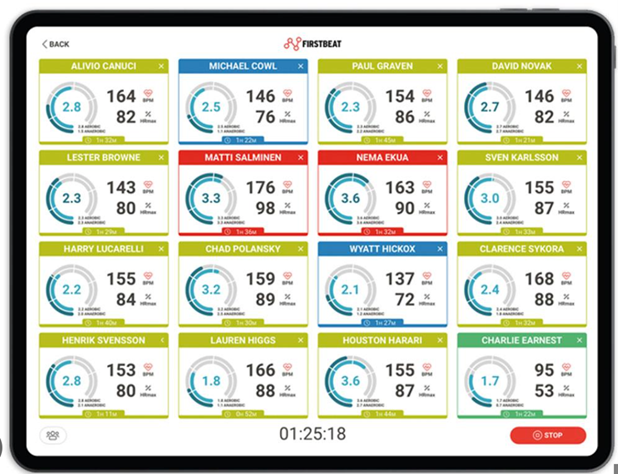
When it comes to live monitoring, Gavin recognizes the importance of how taking action in the moment and using data to make even small tweaks can have positive effects on a training session.
“Yeah, it’s really important for us to not always do things after the fact. So I’m miked up with Georgia. She’s on the side of the field. I’m kind of on the field or just going up to the coaching staff and when feedback is needed, feedback is given.
You also don’t want to just be this foghorn kind of constantly blurting out things, it’s more a case of when something needs to be addressed we address it. When we set goals for the day, and we are trying to achieve a certain amount of conditioning load, this becomes invaluable.
Being able to have a look and see, knowing an athlete’s baseline data, knowing that a big day for him would be 140 TRIMP for instance. So almost having that kind of cheat sheet on the side and knowing like ‘Hey, where are we trying to get to with the plan that we have this whole set’, and then that means that we can extend an extra set. We use TRIMP as a very important indicator for us.
That live monitoring of external and internal load even to the point of sometimes I go to the coach and say ‘Maybe this grid we need to open it up just slightly,’ and it’s incredible how just the difference of another five meters making something longer, all of a sudden shot the external load numbers, probably overshot them. Micro changes like that can have good effects.”
Creating a Unique Fingerprint for Each Athlete
When it comes to return-to-play scenarios, Gavin believes that having an individualized ‘fingerprint’ of data for each athlete which is essential to getting back to the team environment.
“I’ve heard the phrase before, ‘You fingerprint your athletes’. I think that phrase is specific around fingerprints being unique. I know that there are fingerprint warm-ups. There are repetitive drills that can be used and then you can use internal monitoring, you can use the new function with Firstbeat in terms of their recovery index, where it’s very standardized and you’re trying to obviously then look at deviations and how much recovery there is.
For every athlete, we have a data set of what their -4, -3,-2, -1 generally looks like. In my experience, having been in the league for a number of years, coaches are repetitive, and everyone’s got their habits. Everyone’s got their favorite set of drills.
And so the longer you are with the same coach, the more your data set grows, and the more the -4’s look like -4’s, right? We’re growing our dataset in terms of -4,-3,-2,-1 with this coaching staff and with a pretty consistent schedule.
So, if an athlete is injured, and we are trying to recondition him, what are we trying to recondition him towards? For team participation, of course, but what are the demands of that athlete in full participation?
When do we think we’re going to reintroduce him? Are we going to re-introduce him on a day before a game? Generally, we don’t like doing that because obviously, the team’s focus is now on the game and the preparation, and you don’t want to put a new player into the team.
So generally introductions are either happening around the -4 or -2. Those generally are lighter-load training sessions, both externally and internally. And introducing a player for the first time in a matchday -3, you’ve got to be pretty certain that he’s able to tolerate that load, and our internal load unique fingerprint of an athlete shows the average values.
So, the message behind it is to know your athlete and know what the demands are that your athlete experiences when he is fully fit, therefore you know what you’re preparing him towards.
And so, if your reconditioning sessions, have your player only hitting 60 to 80 TRIMP scores and you want to introduce them into a matchday -3, good luck because not only is reconditioning an athlete on his own completely different from when he’s having to go into a small sided game, or he has to do a 10v10 possession, or things are firing at him and there are the cognitive elements, physical elements, and the reactive element. You can’t simulate all of that in reconditioning.
So even if you do get 100 TRIMP in reconditioning an athlete one on one, it’s not exactly as 100 TRIMP profile in a football environment, but at least it gets him close enough. Individualizing your return to play on internal and external loads is vital to getting these guys back to a team environment.”
Watch the full webinar to hear more of Gavin’s valuable insights and download our Firstbeat training load guide for soccer coaches to learn more about some of the metrics Gavin discussed in his interview.
If you liked this article, you should subscribe to our newsletter.
You might also be interested in

Investing in Long-Term Player Development with Finnish Ice Hockey Champions Tappara
“I think it’s important to develop the players all the way from a young age progressing towards the elite league. We have a strength and conditioning team that involves coaches from U18 and U20. We meet on a regular basis.”
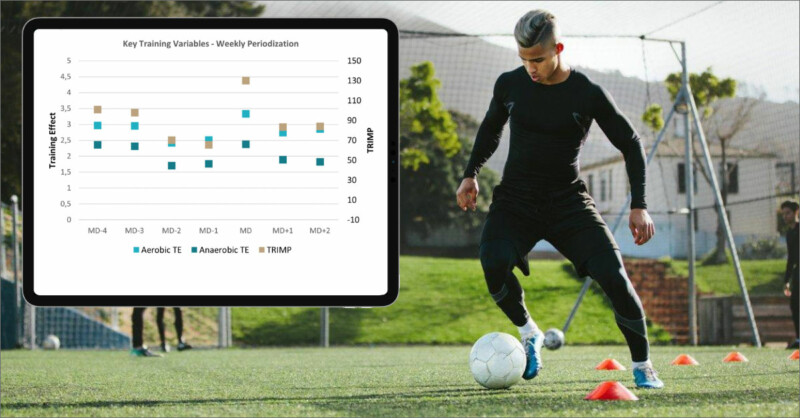
Micro-Cycle Periodization in Soccer – How to Structure the Game Week
Preparing for each game is perhaps one of the most important considerations when coaches are planning their weekly training schedule, as they aim to arrive at game day with players as fresh as possible.
